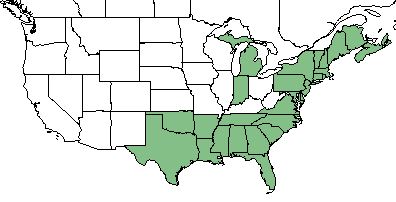Difference between revisions of "Utricularia radiata"
(→Distribution) |
|||
| Line 26: | Line 26: | ||
==Distribution== | ==Distribution== | ||
| − | This species occurs from Nova Scotia, New Brunswick, and Maine, southward to southern Florida, westward to Texas, and disjunct in western Virginia, western Tennessee, and northwestern Indiana. Reports of it occurring in Cuba and South America are in error according to Weakley.<ref name="Weakley 2015"/> | + | This species occurs from Nova Scotia, New Brunswick, and Maine, southward to southern Florida, westward to Texas, and disjunct in western Virginia, western Tennessee, and northwestern Indiana. Reports of it occurring in Cuba and South America are in error according to Weakley.<ref name="Weakley 2015"/> Disjunct populations are also reported in southwestern Michigan.<ref name="Reznicek 1994">Reznicek AA (1994) The disjunct coastal plain flora in the great lakes region. Biological Conservation 68:203-215.</ref> |
==Ecology== | ==Ecology== | ||
Revision as of 13:26, 16 February 2018
| Utricularia radiata | |
|---|---|

| |
| Photo by Fred Nation hosted at Atlas of Florida Plants | |
| Scientific classification | |
| Kingdom: | Plantae |
| Division: | Magnoliophyta - Flowering plants |
| Class: | Magnoliopsida - Dicots |
| Order: | Scrophulariales |
| Family: | Lentibulariaceae |
| Genus: | Utricularia |
| Species: | U. radiata |
| Binomial name | |
| Utricularia radiata Small | |

| |
| Natural range of Utricularia radiata from USDA NRCS Plants Database. | |
Common Names: floating bladderwort; small swollen bladderwort;[1] little floating bladderwort[2]
Contents
Taxonomic Notes
Synonym: U. inflata var. minor[1]
Description
Utricularia radiata is a dioecious annual or perennial that grows as a forb/herb.[2] Seedlings lack cotyledons.[3] It has inflated conspicuous petioles and floats on top of water.[4] This species reproduces sexually and by fragmentation. It produces winter buds/turions and has an unrooted growth form.[5] Its size ranges from 0-1 ft (0-30.5 cm) and flowers are yellow and 0.5 in (1.27 cm).[6]
Distribution
This species occurs from Nova Scotia, New Brunswick, and Maine, southward to southern Florida, westward to Texas, and disjunct in western Virginia, western Tennessee, and northwestern Indiana. Reports of it occurring in Cuba and South America are in error according to Weakley.[1] Disjunct populations are also reported in southwestern Michigan.[7]
Ecology
Habitat
U. radiata occurs in ponds, depression ponds, lakes, and ditches.[1] In Nova Scotia, it typically grows in 1-3 m deep water and is associated with Brasenia shreberi.[8]
Phenology
In the southeastern and mid-Atlantic United States, U. radiata flowers from may through November.[1]
Conservation and Management
Cultivation and restoration
Photo Gallery
References and notes
- ↑ 1.0 1.1 1.2 1.3 1.4 Weakley AS (2015) Flora of the Southern and Mid-Atlantic States. Chapel Hill, NC: University of North Carolina Herbarium.
- ↑ 2.0 2.1 USDA NRCS (2016) The PLANTS Database (http://plants.usda.gov, 15 February 2018). National Plant Data Team, Greensboro, NC 27401-4901 USA.
- ↑ Kondo K, Segawa M, Nehire K (1978) Anatomical studies on seeds and seedlings of some Utricularia (Lentibulariaceae). Brittonia 30(1):89-95.
- ↑ Further notes on coastal floral elements in the bogs of Augusta County, Virginia. Rhodora 42(495):86-93.
- ↑ Capers RS, Selsky R, Bugbee GJ (2009) The relative importance of local conditions and regional processes in structuring aquatic plant communities. Freshwater Biology 55(5):952-966.
- ↑ Plant database: Utricularia radiata. (15 February 2018) Lady Bird Johnson Wildflower Center. URL: https://www.wildflower.org/plants/result.php?id_plant=UTRA
- ↑ Reznicek AA (1994) The disjunct coastal plain flora in the great lakes region. Biological Conservation 68:203-215.
- ↑ Hill NM, Boates JS, Elderkin MF (2000) Low catchment area lakes: New records for rare coastal plain shrubs and Utricularia species in Nova Scotia 102(912):518-522.